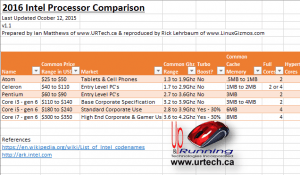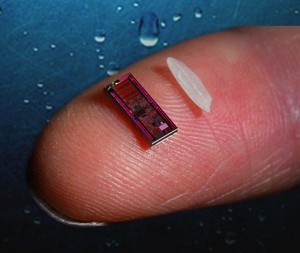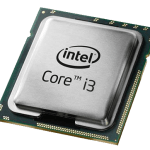Over the years Intel has released a number of variations on their CPU’s and started some lines that have since faded out (does anyone remember the Core 2, Pentium Pro or DX Math coprocessor). So there is no mystery why many people find Intel’s current 


 lines mysterious. They just don’t know if an Atom is more powerful than an i7. This page provides a simple explanation of the differences between Intel’s 2015 and 2016 processor products. To the right is a simplified chart explaining the primary technical differences between current Intel CPU’s and below are very brief descriptions explaining each products history and application.
lines mysterious. They just don’t know if an Atom is more powerful than an i7. This page provides a simple explanation of the differences between Intel’s 2015 and 2016 processor products. To the right is a simplified chart explaining the primary technical differences between current Intel CPU’s and below are very brief descriptions explaining each products history and application.
Intel Atom:
.
Intel Celeron:
Historically Celeron was Intel’s low performance CPU based on two year old mainstream CPU’s, but in 2015 Celeron is really the new name Atom’s. Intel keeps refining the Atom processor, making it smaller and more powerful while at the same time continuing to make it smaller and producing less heat. These CPU’s are now called Celeron. You can easily tell if the CPU you are looking at is really a Atom simply by looking at the power consumption. If the CPU used less than 15 watts of power, it’s really an Atom. That is a good thing because these Celeron/Atom processors are very powerful; often more powerful than Core i3 CPU’s. Current generation Celerons do not use fans to cool them, which is a big deal for noise and battery life.
.
Intel Pentium:
Intel now uses the Pentium brand to keep producing their old technology. They already paid for the technology design and the factories (what they call a ‘Fab’), so why not keep fabricating the old units. They often make minor (but annoying) modifications to their former Core series processors (like eliminating Hyperthreading or Turbo Boost), to help consumers clearly differentiate their new Core i3’s and i5’s from the Pentium line. On a bright note, they also adjust the price to match this drop in functionality so I suppose it is a fair trade.
.
Intel Core i3 – Generation 6:
.
Intel Core i5 – Generation 6:
The Core i5 series is a nice bump on the i3’s. In many ways the i5 is Intel’s standard CPU. It runs very fast and has all features except Hyperthreading which is not critical when you have 4 real CPU’s pulling for you. The i5 is only about $40 more than an equivalent i3 and really worth that difference.
.
Intel Core i7 – Generation 6:
The i7 is the benchmark CPU. With 4 ‘real’ cores plus 4 Hyper Threads, all run


ning at the fastest speed in the industry, this is the top performer. If you buy an Intel i7 CPU that has it’s model name including ends with a “K”, you can overclock it… a lot! . These i7 CPU’s are really only of value to gamers and compute intensive (i.e. scientific work like processing seismic data). For most intensive home or business applications the i7 is simply overkill.
.
So which is the right CPU for you?
That is really dependent upon your requirements but for most people the latest batch of Celerons have the power to drive any co


mmon application and the i5 can be used by those with serious performance needs. All of the other CPU’s should generally be relegated to special use cases. In particular, I would not personally consider an Atom, Pentium or i3 unless it was at an extreme discount. Even though there is nothing wrong with those products they are outclassed by the less expensive, cooler, smaller, Celeron.
.
Which Intel CPU is right for Your Company?
For my corporate clients I sell over 95% of their PC’s with i5’s. The i5 is still inexpensive and will anything most companies ask of it, including running three 4K screens. The reason I sell mostly i5’s is because the usage model on PC’s changes. Today they may need machines for boardrooms, but those PC’s may be repurposed in 16 months for some project. I need to provide a versatile option that sells in the $800 range and the i5 fits those requirements.
.
It should be noted that I had intended to develop this analysis for quite some time, but Rick Lehrbaum of
www.linuxGizmos.com inquiry about co-authoring this is what got me to prioritize this. Thanks Rick!






View Comments